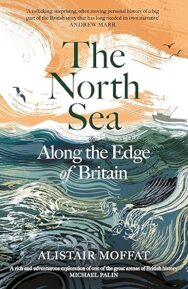‘As we sailed away, back to safe harbour, from this structure that had no business being there, standing sentinel in the midst of the sea for more than 200 years, I knew that I had been privileged to see one of the wonders of the modern world.’
Alistair Moffat mixes history and travelogue in his latest book, The North Sea. In this extract he travels to the Bell Rock to investigate the story of the Stevenson lighthouse that dominates the skyline.
The North Sea: Along the Edge of Britain
By Alistair Moffat
Published by Canongate
Seven years after Robert Stevenson had surveyed the Bell Rock, the Commissioners of the Board of Northern Lights were at last persuaded that a lighthouse should be built on it. But not by Stevenson. John Rennie had designed and overseen the construction of canals and aqueducts as well as taking a leading role in drainage schemes in the Fens. At Kelso, my hometown, he was responsible for a beautiful bridge over the Tweed that has stood many tests of time. Rennie’s insistence that its piers should be sunk more than two metres into the bedrock below the river, the diggers protected by coffer dams, made the structure immensely strong and durable. It was the model for London’s Waterloo Bridge.
Economic arguments were also persuasive for the Commissioners. In the second half of the eighteenth century victorious campaigns against the French in Canada and India had given Britain a vast and potentially very lucrative empire. Merchant shipping was the only means of bringing raw materials to the mills and factories of an industrialising British economy, and far too many cargoes and men were being lost at sea. A light on the Bell Rock would also greatly enhance the developing economy of Dundee. Raw flax for the city’s linen mills was being imported from Russia and the Baltic, while commercial whaling had begun in the 1750s. These valuable cargoes needed safe access to the mouth of the Tay.
*
On 16 August 1807, with a rousing send-off from Arbroath harbour, the first work party sailed out to the Bell Rock. Their immediate task was to clear it of seaweed and the melancholy litter left by shipwrecks. The plan was to build barracks so that workers did not have to be ferried back and forth from the shore or spend periods of high tide on board the lighthouse ship, and footings had to be prepared for the cast-iron skeleton of the structure. Most important was the digging of the wide foundation pit for the base of the lighthouse. Hacked out of the rock with picks, pinches and chisels (which needed constant maintenance from blacksmiths), the pit needed to be perfectly flat and perfectly circular. Sixty centimetres deep, it would hold the first two courses of granite in place, and eventually the whole lighthouse, planted like a post in a posthole.
It was wet, slippery and dangerous work – and at one point almost fatal. On one autumn day the lighthouse ship broke away from its moorings and left Stevenson and his work party of thirty-two men stranded on the rock. The tide was rising as they watched the ship drift further and further away, and disaster loomed. It was only a matter of time before the incoming tide engulfed them. There were two small boats used to transfer materials from the ship, but they could only take a few of the men. Stevenson later recalled:
‘Not a word was uttered by any one, but all appeared to be silently calculating their numbers . . . The workmen looked steadfastly upon the writer [Stevenson] and turned occasionally towards the vessel, still far to leeward. All this passed in the most perfect silence, and the melancholy solemnity of the group made an impression never to be effaced from the mind.’
But then good fortune suddenly intervened. One of the men thought he could make out a boat on the horizon, sailing out towards them from Arbroath. It was a supply vessel bringing letters – and salvation.
Landing granite blocks on the rock that weighed a ton, with nothing but simple, hand-winched cranes and muscle power, was proving very difficult, and as he did throughout the life of the project, Robert Stevenson had to be inventive, find a better way of doing things. To get the stones from the safe landing place to the foundation pit, he had a short railway built and a small bogey adapted which the workers could push. It was vital to move these blocks very carefully, without chipping them in any way. Their shape, carved by the masons in the Arbroath work yard, was crucial to the strength and the durability of the lighthouse. What, in essence, Stevenson had designed was a huge three-dimensional jigsaw, and it had to fit together perfectly to form strong foundations and the walls of the tower that would rise from them.
At the work yard in Arbroath wooden moulds were made and fitted together in what was both a trial run and a guide for the masons. Each stone was carved like a jigsaw piece that would fit only into the stones next to it. The blocks of granite forming each course would link together in a circular pattern with a curved outer face before tapering inwards in sinuous lines to where they were butted against the stones next to them so that they interlocked with them, and only them. When the first course had been laid and found to be perfectly level, the second was locked on to it using two techniques. Set at random intervals, joggles were small knobs, protuberances on the bottom of each stone that fitted snugly into exactly matching notches in the one below it. The second means of locking the courses together was to have two holes bored right through a stone and then part of the way through the stone below it. Oak rods known as trenails were then inserted and pushed down until their top ends were flush with the new stone’s upper surface. The ends were then split and wedges driven in to make the trenails as tight as possible. Pozzolana, what the masons called Roman cement, was used to point the seams between the stones. It would set in the wet. All of this very precise and strenuous work was done at speed in the two hours of low tide and with little more than muscle power and determination to make the stones fit. And they did fit, perfectly, giving the tower the immense strength it would need when gales blew in and mighty waves battered its walls.
At the end of March 1808 Robert Stevenson sailed out to the Bell Rock to see what damage the winter’s storms had done to the foundation courses. To his immense relief, not one stone had moved, the jigsaw had stayed in place, the design and all the care taken over the carving had proved itself. That summer the pace of construction quickened. Not only were the barracks completed, housing eleven men and Stevenson himself, but as one course was laid upon another, rising up out of the incoming tide, work could go on a little longer each day. By the end of August 1809 the lighthouse tower was nine metres high, its sheer weight also adding significantly to its strength. By June 1810 the first internal floor had been laid, where the entrance door now is. At the end of August all that remained was the difficult and delicate business of placing the lantern on top of the tower, the whole point and purpose of all that effort, skill and ingenuity.
In February 1811 the Bell Rock light flared for the first time, and since then it has only been extinguished in wartime. Waves thirty-five metres higher than the top of the lantern are whipped up by gales, but none of these mighty storms has made any impression. And nor could the Luftwaffe. Three times in 1940 and 1941 the lighthouse was strafed by machine-gun fire, and on 1 April 1941 a bomb was dropped. It exploded about ten metres from the base of the tower, but it didn’t cause any damage. The Bell Rock light can be seen for thirty kilometres out to sea as its beam rakes over the waves. And almost as much of a comfort, it can also be seen fifty-six kilometres inland, a reassurance for those who waited at home for the safe return of fishermen and sailors.
When the Ultimate Predator circled slowly around the lighthouse, the engines quiet and the passengers all standing on one side, the effect was almost hypnotic. Like others, I stared at the white tower as the sun made it brilliant. Awesome is now a threadbare adjective, but that is how it seemed to me; awe is what I felt, a belly-hollowing sense of awe at this elegant, powerful testament not only to hard, dangerous work and ingenuity but also to selflessness. The Bell Rock was built to save lives, and Robert Stevenson patented none of his inventions nor guarded any of the secrets of his methods so that others could use them elsewhere. More lights needed to be built, more lives saved.
As we sailed away, back to safe harbour, from this structure that had no business being there, standing sentinel in the midst of the sea for more than 200 years, I knew that I had been privileged to see one of the wonders of the modern world.
The North Sea: Along the Edge of Britain by Alistair Moffat is published by Canongate, priced £20.00.
ALSO IN THIS ISSUE

 Bookseller Gift Ideas
Bookseller Gift Ideas
‘A stunning debut novel. I devoured this book and fell in love with Cora the main character.’

 The Story of the Christmas No. 1: Misletoe & Vinyl by Marc Burrows
The Story of the Christmas No. 1: Misletoe & Vinyl by Marc Burrows
‘Who knows, maybe ‘Last Christmas’ is now the ultimate Christmas No. 1?’













